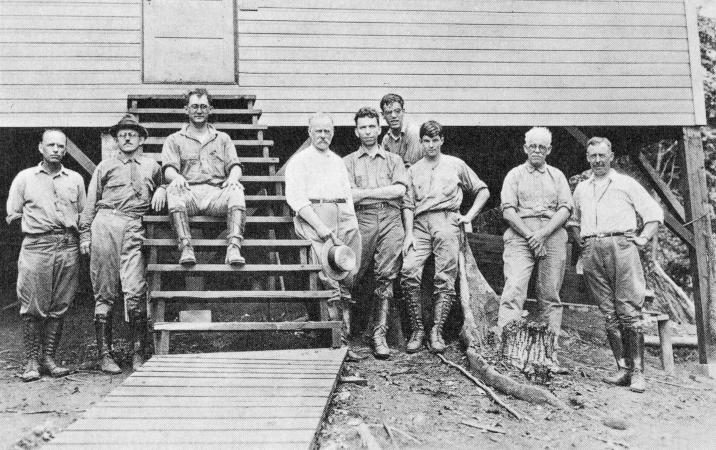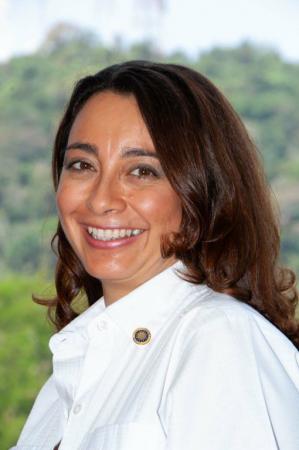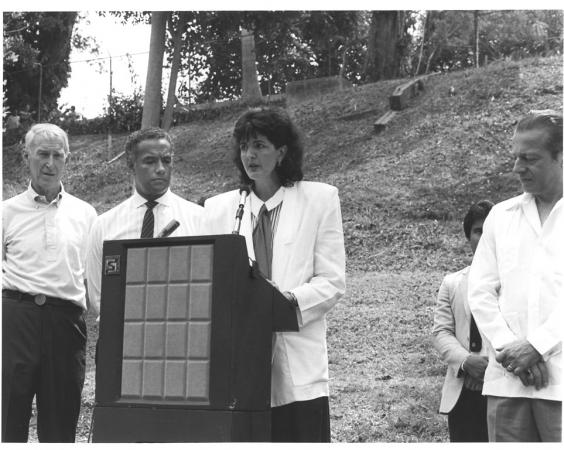In 1924, the Barro Colorado Island (BCI) field station, known at the time as the Canal Zone Biological Area (CZBA), was established in Panama. Today it’s part of the Smithsonian Tropical Research Institute, one of the Smithsonian’s nine research centers. The field station was run and funded by private money until it was transferred to the Smithsonian in 1946, and renamed the Smithsonian Tropical Research Institute (STRI) in 1966.

What do you notice about this photo? The group is primarily comprised of North American white male naturalists photographed standing on land not their own. There are no native Panamanians or women in sight. While we know that North American women naturalists and wives of visiting scientists were on the island and successfully conducted and assisted with research, the field station was dominated by North American white men. The attitudes of these men shaped the misogynistic culture and even the physical infrastructure of the station. When there was a proposal to build separate facilities for women in 1924, the year the photograph was taken, American botanist and donor David Grandison Fairchild rejected the idea. He wrote:
I am myself a married man and as fond of my wife as any man could be but the question is not one of convenience; it is as to whether it is possible, if we let women in, to keep there at Barro Colorado the one thing which to me is absolutely sacred …. Let us keep a place where real research men can find quiet, keen intellectual stimulation, freedom from any outside distraction.
Fairchild’s efforts to keep women off of BCI was directed at white women, both those interested in research pursuits in their own right, as well as the wives of researchers who would often assist their husbands on the island. While we have records of these women conducting research on the island before the Smithsonian took control after the Second World War, they were excluded from staying on the island and participating in the social and intellectual life.
Reading Fairchild’s words reminds us that women’s participation in science and professional spaces was never given. It was earned and hard fought.
In July 2020, 96 years after Fairchild’s declaration that women were a “distraction” to “real research men,” Dr. Oris I. Sanjur, a native Panamanian woman with a Ph.D. in cell development and biology from Rutgers University, was named acting director of STRI.

Sanjur has a long history with STRI beginning in 1989. She has worked as a research assistant, a postdoctoral fellow, manager of the molecular evolution laboratory, associate director for science administration. and, now, as its acting director following the retirement of Dr. Matt Larsen. In her new role she manages 420 employees, an annual budget of $35 million, research facilities throughout Panama, and field sites in Africa, Asia, and the Americas. In addition to numerous honors she’s received for her research and leadership, Forbes recently named Sanjur as one of the most 100 powerful women in Latin America.

How did we get from Fairchild’s misogynistic rebuke in 1924 to Sanjur’s appointment in 2020? Let’s zoom in on the intervening 90 plus years at STRI to understand the shift in culture, gender expectations, and the rightful inclusion of Latin American people. Colonial practice continued as North American white men continued to lead the organization, but we also see that starting in the 1950s, the organization—contending with its own history of exclusion—trusted Latin American women administrators to lead the organization.
James Zetek, manager of CZBA, and third from the left in the top photo, hired Adela Gomez in 1945 as a clerk typist. Gomez, a native Panamanian woman, quickly became invaluable to the operation and administration of CZBA. When Zetek became critically ill and had to leave the island to receive medical care, Gomez took full control, running the day-to-day operations and coordinating with the visiting scientists for eight months from August 1953 until March 1954. The 1954 Smithsonian annual report lauded Gomez’s work, but she was never named “acting manager.”

When Gomez retired in 1984, the Torch, Smithsonian’s staff newsletter, noted:
Gomez worked for four directors (Zetek, Koford, Moynihan, and Rubinoff) and three Smithsonian secretaries (Wetmore, Carmichael and Ripley.) She’s been a physical science aide, an administrative assistant, protocol officer, education counselor and management analyst and, on occasion, acting director.
Other mentions include Gomez serving as acting director “under the supervision of [Director] Ira Rubinoff.” Elena Lombardo, a native Panamanian whom Gomez hired and mentored, also noted in her 2010 oral history interview that she, too, served as acting director during her tenure. Again, there was no formal notice of her role, but there is a clear pattern of STRI’s operations being entrusted to Latin American women.
With this context, we can begin to appreciate the importance that STRI, once a field station on BCI and now a leading research institute on the tropics around the world, is being led by a native Panamanian woman who is a distinguished scientist as well as an experienced administrator.
Related Collections
- Smithsonian Tropical Research Institute History Interviews 2010, 2013, Record Unit 9624, Smithsonian Institution Archives
Related Resources
- For more on the experience of women at Barro Colorado Island, read Institutional Historian Pamela Henson’s “Invading Arcadia: Women Scientists in the Field in Latin America, 1900-1950.”
Produced by the Smithsonian Institution Archives. For copyright questions, please see the Terms of Use.

Leave a Comment